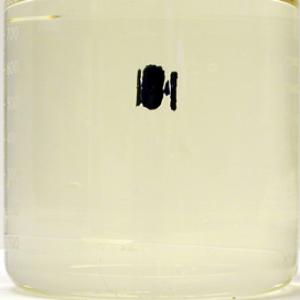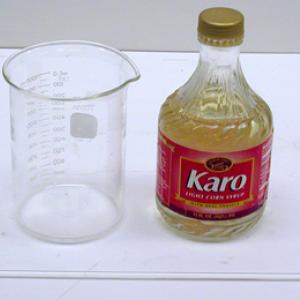College of Liberal Arts & Sciences
6A40.30 - Index of Refraction - Wesson Oil
A popular index of refraction demonstration is to make Pyrex glass disappear by immersion in a liquid with the same index of refraction. Carbon Tetrachloride, Anisole, and Trichloroethylene were used extensively in the past but these are now listed hazardous carcinogens so we try to stay away from them. Immersion oil will also work but it is expensive to get the 200 to 300 ml volume necessary to immerse a test tube.
The cheaper modern day alternative is 'Wesson' vegetable oil and Pyrex glass.
NOTE: If using a test tube you need to have some of the liquid inside the tube also.
Pyrex has an index of refraction of 1.47. The index of refraction for other common liquids are:
Clove Oil - 1. 535
Lemon Oil - 1. 481
Neroli Oil - 1.482
Orange Oil - 1.473
Safflower - 1.466
Vegetable Oil (50 degree C) - 1.47
Oil of Wintergreen - 1.536
Glycerin - 1.473
Karo Syrup has an index of refraction close to soft glass for use with stirring rods and glass cylinders.
It has been reported that Lexan and Glycerin also work well. However, our testing indicates that Glycerin and soft glass works better than Lexan.
Mixing glycerin and water together in different concentrations will work to match most other types of glass.
The "Phantom Crystals" (see 6A40.33) are commonly used as a substitute for soil in potted plants. They are able to absorb a large amount of water and keep it from evaporating, and so they are used to keep plants from drying out under stress conditions. The crystals are a mixture of: 25% Hydroxyethel Methacrylate, methacrylic acid, acrylimide copolymer, cross-linked homopolymer for absorption and desorption of water, and 35% silica to stabilize the system. They have the same index of refraction as water and are therefore invisible in what looks like a beaker of pure water. Shine a laser beam through the beaker and the beam goes straight through as you would expect if the beaker contained only water. Pour some of the water out so the crystals are exposed and you will see the laser beam being refracted by the individual expanded crystals.
- Yu Jin Ahn, Hee Ra Kim, Yu Chen, Ah Reum Yang, Jung Bog Kim, "Changes in Refractive Index and Mass Density Depending on the Concentration of Sugar Water", TPT, Vol. 62, #7, Oct. 2024, p. 604.
- Jialia She, "A Nonlinear Least-Squares Approach for Extimating the Refractive Index of a Liquid", TPT, Vol. 61, #5, May 2023, p. 392.
- Jerry Barretto, "Narrow-Band Invisibility Cloaking: The Vanishing Test Tube Revisited", TPT, Vol. 61, #5, May 2023, p. 371.
- Marshall Ellenstein, "Old Wine in New Bottles", TPT, Vol. 55, #7, Oct. 2017, p. 439.
- Luisa Bragalenti, Andrea Stefanini, Gabriele Tassinari, "Correction: "Water Pearls Optics Challenges for Everybody", TPT, Vol. 52, #6, Sept. 2014, p. 327.
- Marina Milner-Bolotin, "Water Pearls Optics Challenges for Everbody", TPT, Vol. 50. #3, Mar. 2012, p. 144.
- Paul Gluck, "Measurement of Refractive Index of a Liquid", TPT, Vol. 50, #2, Feb. 2012, p. 124.
- Gordon R. Gore, "Physics Fun with Jelly Marbles", TPT, Vol. 47, #9, Dec. 2009, p. 606.
- Christopher J. Olney, "Refractive Index of a Liquid as a Function of Temperature", TPT, Vol. 36, #1, Jan. 1998, p. 46.
- J.M. Dudley and A.M. Kwan, "Snell's Law or Harriot's?", TPT, Vol. 35, #3, Mar. 1997, 158.
- William R. Gregg, "An Old Optics Demonstration - Redone More Safety", TPT, Vol. 31, #1, Jan. 1993, p. 40.
- Walter C. Connolly, "The Cheshire Cat", TPT, Vol. 21, #4, Apr. 1983, p. 263.
- Walter C. Connolly and Thomas L. Rokoske, "The Disappearing Dropper", TPT, Vol. 18, #6, Sept. 1980, p. 467.
- Thomas B. Greenslade, Jr., "Index of Refraction by an Updated Pfund's Method", TPT, Vol. 17, #9, Sept. 1979, p. 394.
- "Refractive Index of Liquids", TPT, Vol. 17, #4, Apr. 1979, p. 258.
- Donald K. Day, "A Safe Pyrex 'Vanishing Solution'", TPT, Vol. 15, #7, Oct, 1977, p. 438.
- Donaldl K. Day, "A Safe Pyrex "Vanishing Solution", TPT, Vol. 15, #7, Oct. 1977, p. 438.
- F. J. Wunderlich, D. E. Shaw, and M. J. Hones, "Pyrex "Vanishing Solution", TPT, Vol. 15, #2, Feb. 1977, p. 93.
- "New Life for an Old Device: The Ring Interferometer", TPT, Vol. 24, #1, Jan. 1986, p. 52.
- N. Venugopal and V. Srinivasan, "Liquid Lens", AJP, Vol. 50, #6, June 1982, p. 554.
- J.H. Jones, J.B. Overcash, J.M. Trostel, J. Mandras, R.L. Chaplin, "Measuring Optical Properties of Liquids with a Laser", AJP, Vol. 50, #2, Feb. 1982, p. 158.
- Paul O. Scheie, "Refractive Index of the Beer", AJP, Vol. 46, #4, April 1978, p. 426.
- K. Hagenbuch and B. Scott, "Comment on the Note "A Simple, Sensitive Method for Measuring the Refractive Index of a Liquid", AJP, Vol. 45, #10, Oct. 1977, p. 1004.
- K. Tennakone, "A Reply to Comment on "A Simple, Sensitive Method for Measuring the Refractive Index of a Liquid", AJP, Vol. 45, #10, Oct. 1977, p. 1004.
- O-215: "Beaker-in-a-Beaker", DICK and RAE Physics Demo Notebook.
- O-216: "Crushed Tube Made Whole-Spoof", DICK and RAE Physics Demo Notebook.
- Wallace A. Hilton, "G-4, Experiments in Optical Physics, p. 12.
- 50 Fun Experiments for the Mad Scientist in You, "Floating Water Magic Trick", National Geographic Kids, p. 79.
- Robert Ehrlich, "10.7, Invisibility Using Equal Indices of Refraction", Why Toast Lands Jelly-Side Down, p. 163.
- Vicki Cobb and Kathy Darling, "Clearly Nothing", Bet You Can!, p. 56.
- Borislaw Bilash II and David Maiullo, "Where Did It Go?", A Demo a Day: A Year of Physics Demonstrations, p. 336.
- Alfred F. Leung, Simon George, Edited by Karl Mamola, "Simple Homemade Container for Measuring Refractive Index", Apparatus for Teaching Physics, p. 203.
- Jearl Walker, "6.89, Magic of Refraction", The Flying Circus of Physics Ed. 2, p. 279.
- "Disappearing Glass", PIRA News, Vol. 8, #5, Apr. 1994.
- "Disappearing Glass Rods", Science Snackbook, p. 40.1 - 40.2.
- "Index of Refraction", PIRA Newletter, Vol. 3, # 17, p. 9, 1990.
- Paul Doherty, "Hands-On Science In Class and Out", The Exploratorium, p. 12.
- Ron Hipschman, "Disappearing Glass Rods", Exploratorium Cookbook II, p. 104.1 - 104.4.
- T. D. Rossing, C. J. Chiaverina, "#4. Disappearing Drinking Glass", Light Science, Physics and Visual Arts, p. 101.
- Brian Jones and Matt Fackelman, "Vanishing Rods", Don't Forget the Duct Tape, p. 145 - 148.
- "Disappearing Test Tube in Salad Oil", Physics From the Junk Drawer, 3rd Edition, The Science House, North Carolina State University, p. 47.
- Tik L. Liem, "The Magic Oil", Invitations to Science Inquiry - Supplement to 1st and 2nd Ed. p. 90.
- Julius Sumner Miller, Q199 & A199, Millergrams II – Some More Enchanting Questions for Enquiring Minds, p. 57 & 108.
Disclaimer: These demonstrations are provided only for illustrative use by persons affiliated with The University of Iowa and only under the direction of a trained instructor or physicist. The University of Iowa is not responsible for demonstrations performed by those using their own equipment or who choose to use this reference material for their own purpose. The demonstrations included here are within the public domain and can be found in materials contained in libraries, bookstores, and through electronic sources. Performing all or any portion of any of these demonstrations, with or without revisions not depicted here entails inherent risks. These risks include, without limitation, bodily injury (and possibly death), including risks to health that may be temporary or permanent and that may exacerbate a pre-existing medical condition; and property loss or damage. Anyone performing any part of these demonstrations, even with revisions, knowingly and voluntarily assumes all risks associated with them.


